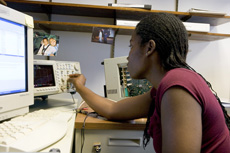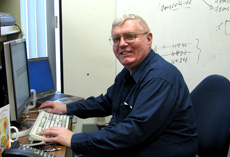|
Reminder:
An IDES representative will conduct group meetings at 11 a.m. and 12 p.m. in the Wilson Hall One West conference room on Friday, March 21, and Friday, March 28.
New furlough information, including an up-to-date Q&A section, appears on the furlough Web pages daily.
|
|
Wednesday, March 19
2-3:30 p.m.
Central Unix Web Service Town Meeting - One West
3:30 p.m.
DIRECTOR'S COFFEE BREAK - 2nd Flr X-Over
4 p.m.
Fermilab Colloquium - One West
Speaker: J. Mastrianni, University of Chicago
Title: Prions: Misfolded Proteins and Fatal Transmissible Neurodegenerative Diseases
Thursday, March 20
1 p.m.
Physics and Detector Seminar - West Wing, WH10NW
Speakers: J. Brau, University of Oregon, J. Jaros, Stanford Linear Accelerator Center
Title: Report from the GDE/ACFA Meeting at Sendai
2:30 p.m.
Theoretical Physics Seminar - WH-3NW (NOTE LOCATION)
Speaker: A. Atre, Fermilab
Title: Heavy Quarks Above the "Top" at Hadron Colliders
3:30 p.m.
DIRECTOR'S COFFEE BREAK - 2nd Flr X-Over
THERE WILL BE NO ACCELERATOR PHYSICS AND TECHNOLOGY SEMINAR TODAY
Click here for NALCAL,
a weekly calendar with links to additional information. |
Wednesday, March 19
- Portabello harvest grain
- Smart Cuisine: Roasted pepper & artichoke quesadilla
- Hoisin chicken
- Smart Cuisine: Normandy stoganoff
- Cuban panini
- Assorted pizza slices
- Pesto shrimp linguini w/leeks & tomatoes
Wilson Hall Cafe Menu |
|
Wednesday, March 19
Lunch
- Trout almondine
- Lemon scented rice
- Vegetable of the season
- Amaretto cheesecake
Thursday, March 20
Dinner
- Seviche
- Paella
- Watercress, oranges & red onion salad
- Brazo de gitano
Chez Leon Menu
Call x4598 to make your reservation. |
|
|
Mentors needed for SIST

LaTToya Harris, a Summer Internships in Science & Technology program participant in 2006, works on a project for the Antiproton Source.
Each year, 15-20 undergraduates from colleges across the country come to Fermilab to participate in the Summer Internships in Science & Technology program. This intensive 12-week program succeeds year after year not only because of the highly motivated interns but also because of dedicated mentors. And this year, SIST needs additional Fermilab scientists to mentor students.
"We want the interns to have jobs that have some sort of scientific or engineering value," said Accelerator Division's Elliott McCrory, head of the Fermilab SIST Committee. "They need to understand how their job enhances Fermilab."
The SIST program begins at the end of May and concludes in August with a series of presentations given by the interns based upon their summer projects. Each intern also writes a final paper, which will appear online. "SIST gives students real work experience because they do actual projects that a section or division needs to get done," said Dianne Engram, head of Fermilab's Equal Employment Office, which has funded the summer program since it began nearly 38 years ago. "Mentors get the opportunity to guide a young person and strengthen that person's resolve for a challenging career."
Any Fermilab employee or user stationed at the laboratory for more than half of the 12 weeks can volunteer as a mentor. Fermilab's EEO pays the interns a weekly stipend and covers the program's general costs. Mentors only need to give their time. "The students are top-notch, and they will get the work done," McCrory said. "But you need to work with the student. If you put time into it, you will find it extremely rewarding."
If you're interested in serving as a mentor this summer, please apply online.
--Elizabeth Clements
|
CD's Steve Fry to retire

Steve Fry, a computing network professional, will retire on Thursday after a 24-year career.
When Steve Fry applied for a Tech 1 position at Fermilab in April of 1984, he was looking for something different. Fry, a public school biology teacher for 13 years, had helped to set up a primitive computer network and computer program for a Glen Ellyn school's science department and thought it might make an interesting career. It did.
Fry, a network analyst in the Computing Division, will shutdown his Fermilab computer on Thursday for the last time. He retires after 24 years of helping to connect and maintain the networks of the laboratory's computer systems.
While helping Fermilab, Fry has enjoyed watching technology evolve and contributing to many upgrades and installations required by decades of advancement. "When I first came here in 1984, people at their desktops had dumb terminals with a data rate of 104 bits per second. Now, people have their own PCs that run at a data rate of 109 bits per second. Even one order of magnitude change is significant, but five is dramatic," Fry said.
Fry said that one his career highlights was working with the laboratory's many experiments. He most recently set up the computer network for the LHC@FNAL Remote Operations Center. "The work is a pleasure, especially once you see how important of a project this is and how many people benefit from it," Fry said.
Although Fry is ready to retire, he will miss the laboratory, particularly the high-quality people he's come to know and admire during the years. They'll miss him as well, said Mark Leininger, Fermilab's computer security manager, who has worked with Fry for more than 20 years.
"Fry is a highly skilled analyst in the network group, with a great attitude and work ethic. The thing I'll remember most about him is that he's always got a smile on his face and something pleasant to say. Everyone who knows Steve will miss him professionally and personally. I know he will enjoy retirement as he pursues his love for classical music and begins a new adventure learning to play the piano," Leininger said.
During his retirement, Fry and his wife, Leronna, plan to add to their reading library and Fry's classical music collection. He also may take up substitute teaching again. "Then I'll have come full circle," Fry said.
Say farewell to Steve Fry at the Venice Tavern today at noon. The luncheon costs $15 per person and includes food, drink, tax, tip and a gift. Call Mark Leininger at x4776 for more information or to reserve a seat.
--Rhianna Wisniewski
|
|
|
Exciting times
Lothar Bauerdick, director of the CMS Center at Fermilab, wrote today's column.
 |
| Lothar Bauerdick |
As we get the CMS detector ready for data-taking, it is evident that we are living in exciting times. Many of the assembly activities, which have occurred over several years,
are now coming to a successful end. The lowering of the 15 huge, heavy detector pieces, from the surface building where they were constructed into the CMS cavern 100 meters underground, was spectacular. The final piece was lowered
at the end of January, ending a 14-month campaign.
Lowering was no easy feat. The CMS access shaft is just large enough to
fit each slice of the detector. These pieces, weighing up to 2,000 tons,
were lowered by an enormous gantry crane through the shaft with sometimes only centimeters of clearance. The lowering team performed this difficult task safely and with great precision, and they succeeded without accident or damage. One could really only appreciate the mind-boggling dimensions of this feat by seeing it.
We are now close to completing assembly of the underground detector. Only the
Pixels Detector and the Endcap Electromagnetic Calorimeter (including the
Preshower Calorimeter) remain. We also continue to do a lot of cabling and infrastructure work to advance commissioning of the entire detector.
The focus now moves to taking test data and reading out data sets recorded by the detector subsystems as one piece. Last week's Global Run included most of the subdetectors. It achieved data rates that approached the rates expected when the proton-proton collisions start. This week, all data is being reconstructed with the latest software version and distributed from CERN to Tier-1 centers, including Fermilab, and Tier-2 centers for data analysis by CMS physicists around the world.
At the LHC Technical Committee workshop that ended last week, we gained a better understanding of this year's LHC run plan. Later this year, we are looking forward to recording collisions at energies much above the Tevatron's. CMS will be ready to have its first look at the secrets behind the new energy frontier!
|
ES&H weekly report, March 18
This week's safety report, compiled by the Fermilab ES&H section, includes one minor, non-reportable first-aid case. The full report is available here.
Safety report archive
|
Flipping particle could explain missing antimatter
From New Scientist, March 18, 2008
It is one the biggest mysteries in physics - where did all the antimatter go? Now a team of physicists claims to have found the first ever hint of an answer in experimental data. The findings could signal a major crack in the standard model, the theoretical edifice that describes nature's fundamental particles and forces.
In its early days, the cosmos was a cauldron of radiation and equal amounts of matter and antimatter. As it cooled, all the antimatter annihilated in collisions with matter - but for some reason the proportions ended up lopsided, leaving some of the matter intact.
Physicists think the explanation for this lies with the weak nuclear force, which differs from the other fundamental forces in that it does not act equally on matter and antimatter. This asymmetry, called CP violation, could have allowed the matter to survive to form the elements, stars and galaxies we see today.
The standard model, our best effort to describe the universe's structure, fails to fully explain CP violation. Many alternative theories claim to have the answer, such as those incorporating supersymmetry, extra dimensions and hitherto unseen forces. However, they often invoke new particles, and experiments have yet to turn up evidence of these.
Read more
|
|
Unix Web service meeting
The CD Central Services Group will hold a central Unix Web service town meeting on Wednesday, March 19, to get input on Web needs and long-term Web service direction.
Going to CERN?
Take your camera! Have your photos featured in the Fermilab Remote
Operations Center online gallery. Contact Elizabeth Clements
for details.
Benefit statements
Watch your Fermilab mailbox for your 2007 Annual Benefit Statement. Please take this opportunity to review your benefits. If you have any questions or feedback regarding your statement, please contact the Benefits Administration Office. You may call Mary Todd at x4361; Scott Lindsey, x4362; or Kay Campbell, x3395.
Standard mileage reimbursement rate
The Internal Revenue Service and the General Services Administration have
issued the 2008 standard mileage reimbursement rates as 50.5 cents per
mile, effective March 19, 2008.
Additional Activities
|
|